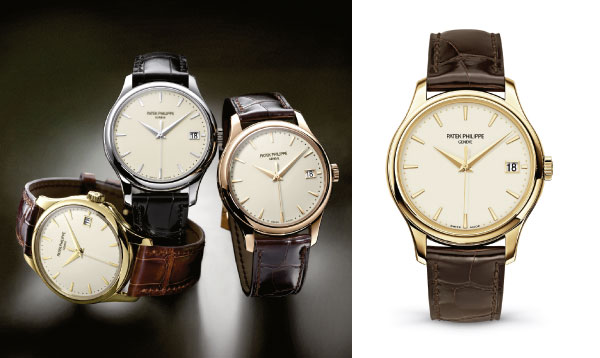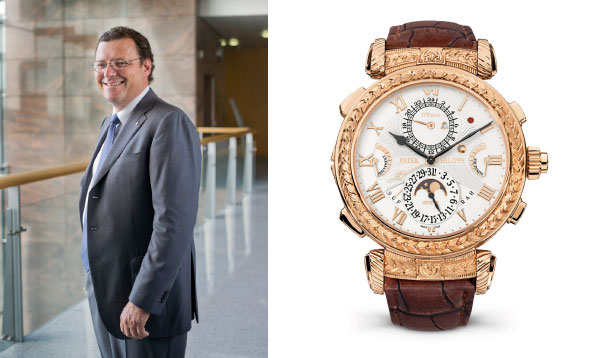
Exterior :
One of the keys to exuding an instant sense of quality naturally lies in the watch exterior. A look at the contemporary collections in the Patek Philippe catalogue clearly reveals a brilliant mastery of its evolution. Take the example of the frenzied indulgence in large diameters that began a decade or more ago. The Geneva-based manufacturer never succumbed to the sirens of instant commercial profit and is now stronger than ever, whereas the beefed-up cases of the 1990s and 2000s have been drastically slimmed down over the past few years in order to meet an eminently more classic standard such as is admirably represented by this reference 5527. Moreover, as well as carefully positioning its products, Patek Philippe also experienced a perfectly smooth transition between Philippe and Thierry Stern. The latter is in the process of asserting his personality, all the while honouring the heritage of his forefathers. This is accomplished by instilling the brand with the perfect blend of innovation and modernity designed to ensure that the venerable institution he is currently heading will continue to shine as brightly as ever. The fine curved grooves cut into the gold case middle and the lugs of the new Calatrava cases, and particularly on this 5227 model, are a most significant example of this approach. Another distinctive feature of this 39 mm-diameter reference is the invisible hinged back cover on the officer-type cases of which the Calatrava collection provides the most appealing interpretations. The rest of the exterior is pervaded by a combination of tradition, purity and classicism. The lacquered and polished dial is cream-coloured and bears gold facetted hour-markers, while the gold hands are of the dauphine type. Exuding such a sense of quality and finishing with such a pure and simple interpretation of time is an authentic master stroke successfully accomplished by the designers and artisans of the Manufacture.
Movement :
The model is driven by self-winding Calibre 324 SC with central seconds and a disc-type calendar display. The going train and the automatic winding system, based on a traditional construction tried and tested by Patek Philippe, brings no real surprises other than renewed admiration for its exemplary finishing. Nonetheless, while all the rules of the art are fully respected, there is nothing ostentatious about that aspect of this watch. Côtes de Genève, circular graining, bevelled steel parts and bridges: the famous “Geneva” quality is omnipresent in an understated manner that would doubtless have pleased Calvin. Nonetheless, the technological innovations developed in recent years are clearly present in this movement, albeit invisible to an inexperienced observer, since most of them are focused on the escapement and the regulating organ : the four-spoke Gyromax® balance wheel and its slotted poising weights, along with the Spiromax® balance-spring in Silinvar® that maintains the oscillations at a frequency of 28,800 vibrations per hour. While these inventions are as yet too recent to enable a long-term vision of how components stemming from these technologies will age, they quite clearly ensure improved timing precision. Calibre 324 SC bears the Patek Philippe Seal with its exceptionally stringent tolerances.
Tests:
A string of figures cannot sum up the timing performances of this movement so readily as the sense of accuracy “metaphysically” radiating from the mechanism. As far as rates are concerned, the Patek Philippe Seal demands a variation in rate of within -3 and +2 secs./day. It is hard to imagine any tighter margins. Our measurements confirmed these tolerances between 0 and 24 hours of operation, with a maximum delta of 4 seconds ! The amplitudes are not excessive and are thus not liable to create any knocking, despite being over 225° in all instances measured. The high inertia of the balance wheel is doubtless largely accountable for that. As far as the power reserve is concerned, which the technical data sheet gives as between 35 and 45 hours, our measures put it at over 41 to 42 hours. The performances of the automatic winding system are remarkable and the 21-carat gold oscillating weight perfectly enhances the efficiency of the reduction-gear. One might almost forget to mention the comfort on the wrist of this reference 5527, since it represents an obvious result of its 39 mm diameter and the finishing of the case.
Conclusion :
When a Patek Philippe visits our test bench, one might almost – driven by a journalistic concern to not seem too indulgent – end up hoping to find a tiny flaw or some weakness in its design and construction. However, a concern to maintain credibility leads to the recognition that Patek Philippe amply deserves the prestigious aura that has raised the brand to the very pinnacle of Fine Watchmaking. Anyone might possibly find that the Calatrava 5527 does not happen to appeal to them, but none would dare to deny how close the watchmaker and this reference have drawn to absolute perfection.






